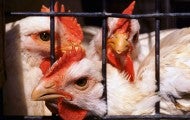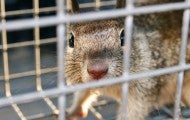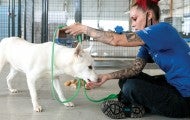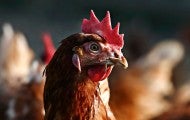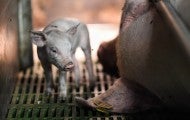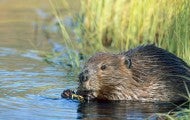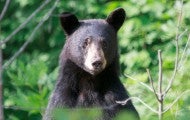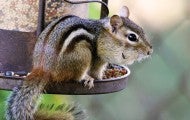Poultry (Each report is available as a downloadable PDF.) CHICKENS AND TURKEYS About Chickens [PDF] About Turkeys [PDF] Animal Welfare in the Chicken Industry [PDF] Animal Welfare in the Turkey Industry [PDF] Caponizing Chickens [PDF] Manual Catching of Poultry [PDF] Transport of Day-Old Chicks [PDF...
WASHINGTON — On January 1, California’s 2018 ballot measure Proposition 12, which set landmark prohibitions on the sale of food products from farm animals locked in cruel and extreme confinement, will be fully implemented in the state. Proposition 12’s egg and veal provisions have been in place for...
This list is provided as a resource for horse owners and is for informational purposes only. Please contact specific vendors for more information on their services. Every effort has been made to ensure the accuracy of all listings. This list is not exhaustive and is subject to change over time. The...
When the U.S.-based rescuers from Humane Society International touched down in Seoul in mid-October, they faced the usual jet lag. But rather than tackle it by jumping head-first into their work—shutting down their 17 th South Korean dog meat farm—they went straight to a hotel … and straight into...
A raccoon in the chimney, a groundhog under the shed, a skunk under the back porch … when confronted with wildlife living up-close in their own homes or backyards, well-meaning but harried homeowners often resort to what they see as the most humane solution—live-trapping the animal and then setting...
Of the more than 150 dogs rescued in October from a South Korean dog meat farm, most have already found loving homes—but a dozen or so require a bit of extra TLC first. Their surroundings at an HSUS-run temporary shelter are a far cry from the filthy, cramped cages where they awaited a gruesome fate...
Around the world, animals used for meat, eggs and dairy often suffer on factory farms where they are treated as units of production rather than living, feeling creatures. The Humane Society of the United States and Humane Society International present comprehensive reports on animal agribusiness and...
Beavers are making a comeback. Nearly driven to extinction by the fur trade, nature’s best architects are now 6–12 million strong in the United States. This return will provide significant benefits to our country’s ecology, which has lost much of its wetlands to development and agriculture. Learn...
As black bear numbers increase in some North American communities and more people move into bear habitat, encounters between bears and people have risen. Whether you live in bear country or are just visiting, you can take simple steps to avoid conflicts. Learn More About Bears (Please note that this...
Rounding up and killing entire flocks of geese has become an all-too-common (and temporary) fix in many communities. Besides being inhumane, this also leaves room for a new flock to just move right in. Geese shouldn’t be killed for doing what comes naturally, especially when long-term, effective and...

